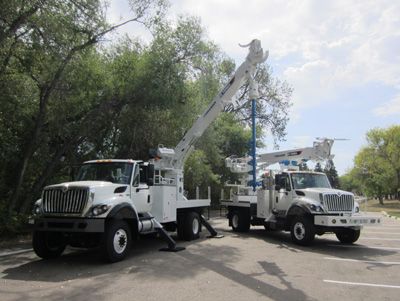
Evaluating Medium-Duty Powertrain Options for Aerial Trucks
Aerial lift trucks are built for low-mileage, high-engine-hour duty cycles, with unique payload requirements. So what should you consider in terms of the powertrain – the engine, transmission and drive axle options – to spec the best chassis for the job? Utility Fleet Professional spoke with Ryan Kloos, chassis technical coordinator for aerial platform manufacturer Terex Corp., to get his advice.
We centered the conversation around an example of a Class 7 chassis, rated up to 33,000 pounds gross vehicle weight (GVW), that might be used for a 50-foot aerial application. This is because smaller trucks typically have only a few engines, transmissions and drive axles to choose from. But when you move up to a Class 7 or heavier chassis, the specification process gets much more complex, with some models offering more than a dozen different powertrain configurations that can significantly impact the truck’s highway speed, fuel economy, performance and price.
UFP: When evaluating diesel engine horsepower and torque ratings, how do you sort through the myriad options to determine the best fit?
Kloos: The big thing is the work environment of that truck. Is it off-road? Will it operate in a mountainous area? Then there are payload and trailering requirements. You want to make sure the truck has enough power to move the weight and pull the trailer, while achieving sufficient top-end speed.
UFP: How does this translate into an actual engine spec?
Kloos: Take the 33,000-pound GVW truck example. If it’s a typical 4×2 application, a smaller 250-horsepower and 660-lb-ft torque [diesel] engine seems to cover most requirements. But when you get into applications where you may be pulling a little bit heavier trailer behind that truck or get into extreme off-road applications or a mountainous area, we’ll look at increasing horsepower and torque from there.
There’s also the cost factor. The higher up you go in engine horsepower, the higher the cost. So, we’re trying to offer as much truck as possible for as little cost as possible. And a 250-horsepower engine in a 33,000-pound GVW truck seems to hit that sweet spot in a wide range of utility applications.
UFP: What about selecting the transmission?
Kloos: The manual transmissions are obviously a lot lower cost and have their advantages as far as [low-gear] performance, but for the most part, the Allison automatic [3000 RDS series] brings a lot of simplicity in terms of driving the truck – and it’s the drivability of the automatic that operators really enjoy.
UFP: Drive-axle gear ratios often seem like an afterthought, but the wrong spec could significantly impact top speed, fuel economy and the ability to handle off-road and steep grade conditions. What should utility fleet managers consider?
Kloos: The big factor when you start talking about gearing is the top speed requirement. In a lot of cases, utility fleets are looking for off-road performance, but they also want to be able to get the truck to run at highway speeds. So it’s a matter of finding that happy medium in there between the transmission gearing and rear-end gearing. We need to configure the spec to meet the max speed, fuel economy and performance requirements.
When you consider a 33,000-pound GVW truck in a 4×2 application, you want it to handle 75 mph highway speed, while still offering good low-end startability. In this case, we typically recommend about a 6.17:1 rear gear ratio with a 250-horsepower engine and six-speed automatic transmission. If you’re pulling a trailer, you would adjust the gear ratio accordingly.
We often receive requests where the customer will say, “Our old truck we’re replacing has a 300-horsepower engine and it’s just not enough power for what we need it to do. So we want our new truck to have 350 horsepower.” But we usually try to explain that the reason the 300-horsepower truck didn’t perform right is because it was geared for a 95 mph top speed. If you don’t need that truck to do 95 mph, we can bring that down a little bit, lower your top gear speed and give you a little bit better performance without you having to spend all the money for a bigger engine.
*****
Rear-Axle Ratio Spec Guidelines
In medium-duty trucks, gear ratios can range from 2.69:1 to 7.17:1, depending on the truck class, make and model, and rear-axle capacity. How do you determine what’s right for your application? The following general guidelines should help point you in the right direction:
• For maximum towing and payloads, and on hilly terrain with steep grades, ratios at or nearing 7.17:1 should be considered depending upon severity.
• When the truck requires flexibility for operating on varied terrain with moderate towing and payloads, ratios in between the extremes should be considered. One can bias toward either end of the spectrum based upon the frequency of off-road events.
• For flat terrain, lighter loads and running at consistent highway speeds, a ratio closer to 2.69:1 should be selected.


